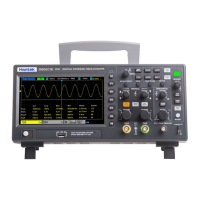23 / 72
8. Press the Holdoff softkey and turn V0 to set the time that the oscilloscope waits before a trigger to
the next trigger, so that complex waveforms are displayed stably.
Note: Press the [Auto Set] button will set the trigger type to Edge and slope to rising.
2.7.2. Pulse Trigger
Pulse trigger sets the oscilloscope to trigger on a positive or negative pulse of a specified width. You can
set the trigger source, polarity (positive pulse width, negative pulse width), limit conditions, and pulse
width in this menu.
1. Press the [Trig Menu] button on the front panel to enter the TRIGGER function menu.
2. Press the Type softkey, turn the Multifunctional Knob to select Pulse and then press the knob to
confirm.
3. Press the Source softkey, turn the Multifunctional Knob to select CH1~CH2 as the trigger source.
4. Turn the Trigger Level Knob to adjust the trigger level to the desired place.
5. Press the Polarity softkey to select Positive or Negative pulse that to trigger on.
6. Press the When softkey, turn the Multifunctional Knob to select the desired condition,
and push down the knob to confirm.
< (less than a time value): trigger when the positive or negative slope time of the input signal is lower
than the specified time value.
For example, for a positive pulse, if you set t (pulse real width) < 100ns, the waveform will trigger.
> (greater than a time value): trigger when the positive or negative slope time of the input signal is
greater than the specified time value.
For example, for a positive pulse, if you set t (pulse real width) >100ns, the waveform will trigger.
!= (not equal to time value): trigger when the positive or negative slope time of the input signal is not
equal to the specified time value.

